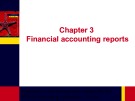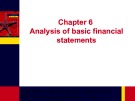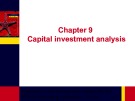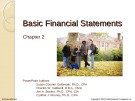
Lecture Accounting for business
-
Chapter 24 - Presentation and disclosure in financial reporting. After studying this chapter, you should be able to: Review the full disclosure principle and describe implementation problems; Explain the use of notes in financial statement preparation; Discuss the disclosure requirements for related-party transactions, subsequent events, and major business segments;...
 74p
74p  haojiubujain04
haojiubujain04
 27-07-2023
27-07-2023
 5
5
 4
4
 Download
Download
-
Lecture Accounting for Business – A non-accountant’s guide (2/e) - Chapter 1: Accounting concepts. After you have mastered the material in this chapter, you will be able to: Explain the accounting entity assumption; define assets, liabilities, owner's equity, revenue and expenses and classify items into assets, liabilities, owner's equity, revenue and expenses; define the accounting equation and describe the link between the equation and the accounting entity assumption;...
 12p
12p  haojiubujain04
haojiubujain04
 27-07-2023
27-07-2023
 7
7
 4
4
 Download
Download
-
Lecture Accounting for Business – A non-accountant’s guide (2/e) - Chapter 2: Double entry bookkeeping. The learning objectives for this chapter include: Explain the principles of the double entry bookkeeping system, state the rules of debit and credit for each group of accounts, describe the flow of information through an accounting system,...
 21p
21p  haojiubujain04
haojiubujain04
 27-07-2023
27-07-2023
 5
5
 4
4
 Download
Download
-
Lecture Accounting for Business – A non-accountant’s guide (2/e) - Chapter 3: Financial accounting reports. The learning objectives for this chapter include: Describe the purpose and format of a statement of financial performance, explain the difference between gross profit and net profit, differentiate between cash and accrual accounting systems,...
 37p
37p  haojiubujain04
haojiubujain04
 27-07-2023
27-07-2023
 7
7
 4
4
 Download
Download
-
Lecture Accounting for Business – A non-accountant’s guide (2/e) - Chapter 5: Basic accounting standards. The learning objectives for this chapter include: Explain the role of accounting standards, define AARF and AASB, outline the process for development of Australian accounting standards, discuss the development of the conceptual framework and the Statements of Accounting Concepts,...
 29p
29p  haojiubujain04
haojiubujain04
 27-07-2023
27-07-2023
 5
5
 4
4
 Download
Download
-
Lecture Accounting for Business – A non-accountant’s guide (2/e) - Chapter 4: Limitations of accounting. After you have mastered the material in this chapter, you will be able to: Explain the term ‘generally accepted accounting principles’; explain the effects of the following accounting principles on the measurement of assets, revenues and expenses: historical cost, monetary unit, going concern, accounting period, conservatism.
 9p
9p  haojiubujain04
haojiubujain04
 27-07-2023
27-07-2023
 8
8
 3
3
 Download
Download
-
Lecture Accounting for Business – A non-accountant’s guide (2/e) - Chapter 6: Analysis of basic financial statements. After you have mastered the material in this chapter, you will be able to: Explain the importance of comparisons and trends in financial statement analysis; calculate the ratios related to the profitability and financial stability of a business, from a given set of financial statements;...
 23p
23p  haojiubujain04
haojiubujain04
 27-07-2023
27-07-2023
 6
6
 4
4
 Download
Download
-
Lecture Accounting for Business – A non-accountant’s guide (2/e) - Chapter 7: Costing concepts. After you have mastered the material in this chapter, you will be able to: Explain the importance of comparisons and trends in financial statement analysis; calculate the ratios related to the profitability and financial stability of a business, from a given set of financial statements;...
 13p
13p  haojiubujain04
haojiubujain04
 27-07-2023
27-07-2023
 11
11
 4
4
 Download
Download
-
Lecture Accounting for Business – A non-accountant’s guide (2/e) - Chapter 8: Short-term decision making techniques. The learning objectives for this chapter include: Describe the role of product and service costing in various types of organisations; define the following costing terms: fixed and variable cost, direct and indirect cost, product and period cost, manufacturing costs; discuss the difficulties associated with accounting for indirect manufacturing costs;...
 27p
27p  haojiubujain04
haojiubujain04
 27-07-2023
27-07-2023
 8
8
 4
4
 Download
Download
-
Lecture Accounting for Business – A non-accountant’s guide (2/e) - Chapter 10: Basic budgetary controls. After you have mastered the material in this chapter, you will be able to: Outline the steps associated with an effective system of management control, explain the benefits of adopting a formal budgeting process, explain the importance of recognising the behavioural aspects of budgeting,...
 14p
14p  haojiubujain04
haojiubujain04
 27-07-2023
27-07-2023
 9
9
 4
4
 Download
Download
-
Lecture Accounting for Business – A non-accountant’s guide (2/e) - Chapter: Capital investment analysis. The learning objectives for this chapter include: Describe the two types of capital investment decisions with which managers may be faced: accept or reject decisions, capital-rationing decisions; describe the method of calculation of non-discounting models: payback period, accounting rate of return; explain the advantages and limitations of non-discounting models;...
 16p
16p  haojiubujain04
haojiubujain04
 27-07-2023
27-07-2023
 8
8
 3
3
 Download
Download
-
Lecture Financial accounting 2 - Chapter 9: Stockholders’ equity. After studying this chapter, you should be able to: identify types of equity; recognition and accounting for shares and other reserves in business; identify types of dividends and accounting treatment for dividends; understand the requirement of disclosure of equity;...
 30p
30p  diepvunhi
diepvunhi
 07-01-2023
07-01-2023
 28
28
 1
1
 Download
Download
-
Advanced financial accounting - Lecture 8: Non-Profit organizations. The main topics covered in this chapter include: statement of affairs; working (office equipment); owner’s equity business organizations; capital fund non profit organizations; cost of goods sold;... Please refer to the lecture for details!
 16p
16p  hanlamcoman
hanlamcoman
 26-11-2022
26-11-2022
 8
8
 2
2
 Download
Download
-
Lecture Financial Accounting (15/e) - Chapter 2: Basic Financial Statements. After completing this unit, you should be able to: Explain the nature and general purpose of financial statements; explain certain accounting principles that are important for an understanding of financial statements and how professional judgment by accountants may affect the application of those principles; explain how the statement of financial position, often referred to as the balance sheet, is an expansion of the basic accounting equation;...
 16p
16p  runordie9
runordie9
 27-09-2022
27-09-2022
 43
43
 3
3
 Download
Download
-
Lecture Financial Accounting (15/e) - Chapter 1: Accounting - Information for Decision Making.
 16p
16p  runordie9
runordie9
 27-09-2022
27-09-2022
 27
27
 2
2
 Download
Download
-
Lecture Financial Accounting (15/e) - Chapter 15: Global business and accounting. In this chapter, students will be able to understand: Define four mechanisms companies use to globalize their business activities, explain why there is demand for harmonization of global financial reporting standards, demonstrate how to convert an amount of money from one currency to another, compute gains or losses on receivables or payables that are stated in a foreign currency when exchange rates fluctuate,...
 17p
17p  runordie9
runordie9
 27-09-2022
27-09-2022
 9
9
 2
2
 Download
Download
-
Lecture Managerial Accounting for the hospitality industry: Chapter 3 - The income statement. In this chapter you will learn why the income statement is so important to all those who will typically review and analyze it. You will also see why it is so critical for the manager who is actually operating the business to be able to read and correctly analyze and interpret the income statement.
 56p
56p  runordie9
runordie9
 27-09-2022
27-09-2022
 12
12
 3
3
 Download
Download
-
Lecture Managerial Accounting for the hospitality industry: Chapter 5 - The statement of cash flows. In this chapter you will learn about the Statement of Cash Flows (SCF). The SCF is a report that tells its readers about increases (inflows) and decreases (outflows) of cash of a business during a specific accounting period.
 46p
46p  runordie9
runordie9
 27-09-2022
27-09-2022
 11
11
 3
3
 Download
Download
-
Lecture Managerial Accounting for the hospitality industry: Chapter 6 - Ratio analysis. Ratio analysis is used to analyze profitability and it is also used to examine, in detail, the asset, liability, and owners’ equity positions of a business. In this chapter you will learn how to compute and analyze the ratios used to evaluate each of these three major components of the basic Accounting Formula.
 64p
64p  runordie9
runordie9
 27-09-2022
27-09-2022
 11
11
 3
3
 Download
Download
-
Lecture Managerial Accounting for the hospitality industry: Chapter 9 - Managerial accounting for costs. This chapter will teach you how to recognize the different types or categories of costs that managerial accountants consider when they analyze the total costs incurred by a hospitality business. The most important of these various types include fixed, variable, step, mixed, direct, indirect, controllable, and non-controllable costs.
 59p
59p  runordie9
runordie9
 27-09-2022
27-09-2022
 12
12
 3
3
 Download
Download
CHỦ ĐỀ BẠN MUỐN TÌM
































